DDJ-Rev1 detailed review. The Pioneer DDJ-Rev1 is an entry-level DJ controller with battle style control layout that you can get for just around $250. Is it a good choice for beginners? Should you get one? We will answer all these questions and more!
Check out also: 5 Best Pioneer DJ Controllers For Beginners – Which one should you choose?
- Control layout
- The mixer section
- Performance pads
- Audio FX section
- Jog wheels
- DDJ-Rev1 tracking pad mode
- Inputs and outputs
- Software compatibility
- Pros and cons
- The conclusion
This web portal is reader-supported, and is a part of the Amazon Services LLC Associates Program and the eBay Partner Network. When you buy using links on our site, we may earn an affiliate commission!
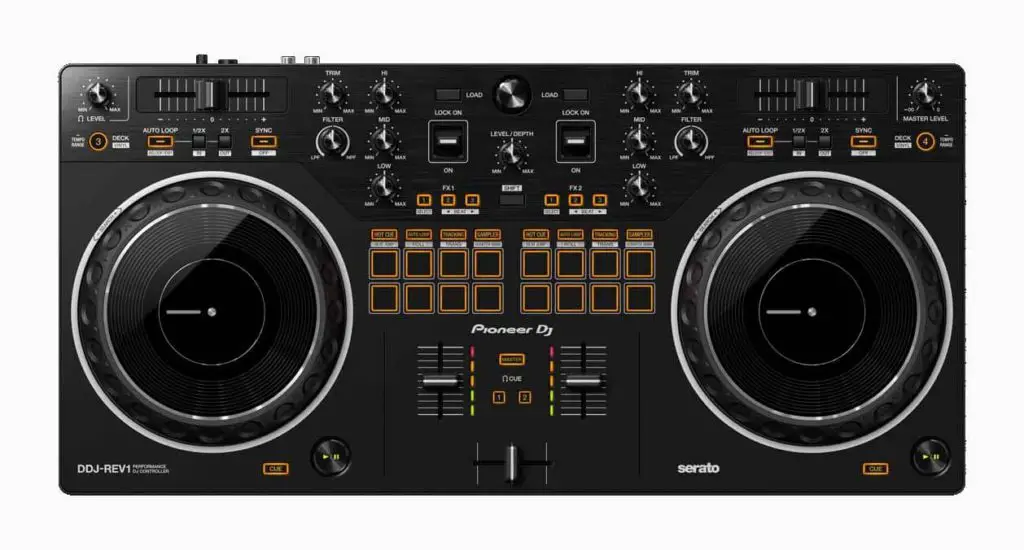
Control layout
The control layout on the Pioneer DDJ-Rev1 resembles a traditional battle style setup – that is two turntables rotated by 90 degrees for scratching convenience and a DJ mixer in the middle.
This is the reason why 1 – the pitch faders on the DDJ-Rev1 are located on top of each deck section, 2 – the play buttons are in the bottom down part of each deck and the cue button which is not normally present on turntables is just a tiny additional button.
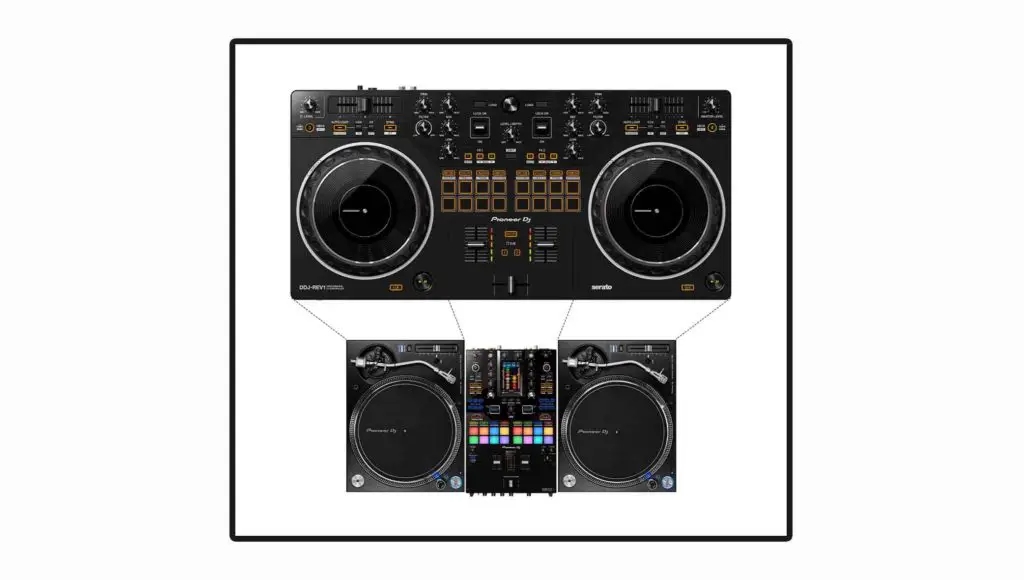
The pitch fader is not a full sized one but it’s really tight and it allows you to set the tempo with precision. It also has a small “click” in the middle indicating the “0” neutral position.
The tempo faders and the crossfader seem to be exactly the same components found on all latest Pioneer DJ entry-level controllers like the DDJ-400 and the DDJ-SB3.
Besides the tempo faders and the play/pause and cue buttons, each deck features a loop section and the additional deck 3/4 control switches that allow you to access virtual decks 3 and 4 during your mix.
There are also headphone level and master level output volume control knobs conveniently placed on the left and right side of the two pitch faders.
The mixer section
The mixer section on the DDJ-Rev1 is pretty wide and packed with features. We’ve got the basic 3-band equalizer, the channel trim (gain) knobs and the filter knobs arranged in a way that corresponds to the Pioneer DJM-S mixer control scheme.

The similarities to the professional Pioneer DJM-S mixer series do not end here however.
Next thing available here, are the library controls (a simple encoder knob and load buttons, not much to talk about here) and the shift button, alongside with the FX paddles and the whole audio FX section (which we will cover in a bit).
The mixer section also features separate LED gain indicators for each mixer channel, located near the audio faders. Here you can also find the headphone cue control buttons.
Beneath the FX section, in the middle of the mixer we have the performance pads (which in a standard club-standard controller layout would be located underneath each deck instead.
Performance pads
The Pioneer DDJ-Rev1 features 8 performance pads for each deck. You can choose and use different pad modes on each deck, as those can be set separately on each set of pads.

DDJ-Rev1 features the following pad modes:
- Hot cue – with Serato DJ Lite you have access only to 4 hot cues on each deck
- Auto loop – a complementary function to the main loop sections
- Tracking – essentially a quasi-auto-scratch feature that controls the crossfader movements while you are only in charge of moving the platter to produce scratch sound patterns.
- Sampler – a simple sampler, again only 4 samples per deck while using Serato DJ Lite
- Beat jump (only with Serato DJ Pro) – allows you to jump a set number of beats forwards or backwards while maintaining the track’s tempo synchronization
- Roll (only with Serato DJ Pro) – quick access to multiple short loop values in pad hold mode
- Trans – a sound “ducking” effect with different accessible beat divisions for each pad (8 trans patterns available)
- Scratch bank – allows you to quickly access custom scratch samples on each deck and then with a press of a button return to the track that was playing before the scratch bank activation
An important thing to mention here, is that some of the pad modes (Beat jump and Roll) are not active with the free Serato DJ Lite software that the DDJ-Rev1 comes bundled with. Moreover, your access to the remaining performance pad modes might be limited while using Serato DJ Lite (for example you might have access only to 4 of the pads in each mode instead of all 8).
With Serato DJ Lite the bottom 4 pads in each performance pad mode (excluding the trans mode and the tracking mode) activate basic transport controls (rewinding the track plus a censor/reverse button).
This method of soft-locking the controller’s features is already known from the DDJ-SB3 – the predecessor of the DDJ-Rev1.
This of course makes this controller a tad less cost effective than it would seem, as if you want to make use of 100% of the DDJ-Rev1 features, you’ll have to purchase an upgrade to Serato DJ Pro software.
The next important thing is that these performance pads are a bit smaller than the performance pads on the DDJ-400 or the DDJ-SB3. This was perhaps a tradeoff that had to be made to fit all the other controls in the tight space between the decks and maintain even a somewhat portable form factor of the device.
Other than that these pads are pretty much the same as the pads on the mentioned Pioneer DJ controllers, with the characteristic “click” sound when pressed down and a soft rubbery finish.
Audio FX section
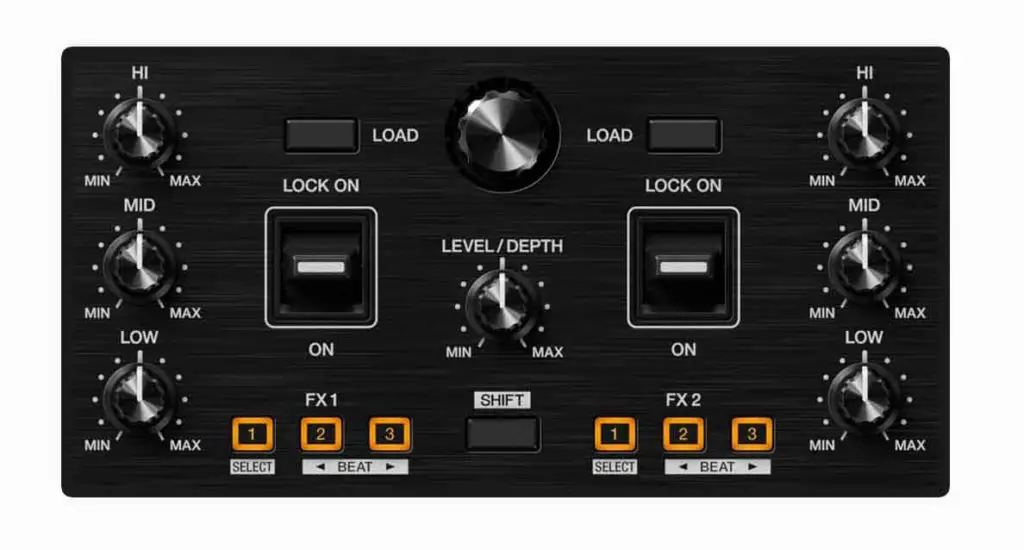
The audio FX section on the Pioneer DDJ-Rev1 consists of two FX activation paddles and two banks of three custom software FX with activation buttons for each effect.
Unfortunately there is only one FX level/depth control knob present here, and you don’t have much control over your FX parameters from the device.
The FX paddles can either activate momentarily when pushed down, or lock up in place when pushed up. All of the effects work as post-fader effects – that is if you move one of the mixer faders down to position “0” when an effect like echo or reverb is active, the sound will still be affected by these and will slowly fade away.
Pioneer DDJ-FLX6 – DJ Controller Overview
You can toggle on and off up to 3 software effects on each deck using the FX paddle, however you can only change the first audio FX from each bank using the controller. To change the remaining two effects, you need to do it using your laptop.
The selection of the first FX in the bank and the beat division FX parameter are controlled using the shift button and the FX activation buttons.
Jog wheels
The jog wheels of the DDJ-Rev1 are supposed to be one of the selling point of the device. They are roughly 6 inches (154 mm) in diameter which makes them about the same size as the jog wheels on the Pioneer DDJ-SX and the DDJ-RX series. This means that those jog wheels are in fact bigger than those present on the Pioneer DDJ-SB3 or the Pioneer DDJ-400.
Those platters are not motorized like the ones on the Pioneer DDJ-Rev7.
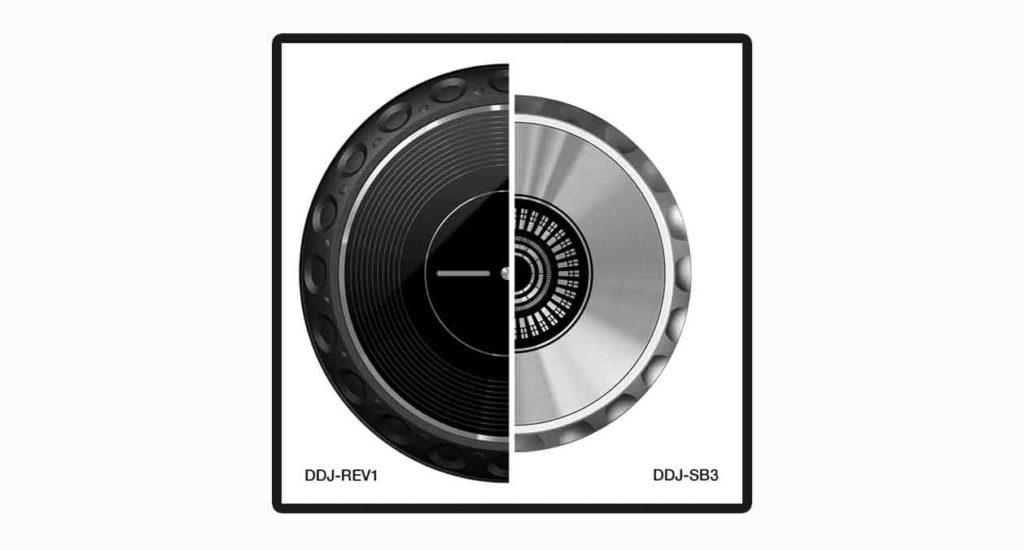
Other than that, the jog wheels on the DDJ-Rev1 have a really nice feel to them, feature a simple needle indicator and a rubbery perforated edge to allow for comfortable pitch bending.
DDJ-Rev1 tracking pad mode – auto scratch feature?
The tracking pad mode when activated controls the crossfader movements for you and returns the track to the cue point automatically when you move the jog wheel. It allows you to perform 6 kinds of scratches without even touching the crossfader. This way you can slowly learn the hand movements necessary for performing each of the scratch patterns without worrying about the crossfader gymnastics.
This kind of behavior places it above the DDJ-SB3 auto pad scratch feature which automatically performed the whole scratch for you without any room for variations or additional control.
All Pioneer DJ Controllers Listed – 10 Years Evolution 2011-2021
The tracking mode enables you to scratch while moving the jog wheel platter in a timely manner without interacting with the crossfader at all. This function works and sounds best with scratch samples (and Serato DJ provides a few of these in the software).
There are a few crossfader scratch patterns to chose from and you can select each one of these using the performance pads when the tracking mode is active.
The scratch patterns available in the tracking mode on the DDJ-Rev1 are:
- Forward Stab
- Reverse Stab
- Chirp
- Orbit
- Crab
- Stab/Baby Combo
You can use all these without upgrading your software to Serato DJ Pro.
Inputs and outputs
DDJ-Rev1 features following inputs and outputs:
| Audio Inputs | Master: RCA output Microphone: 1/4″ jack input |
| Audio Outputs | Headphones: 1/8″ jack output |
| Other | Laptop connection & power: USB Type-B |

Important thing to mention here is that on the DDJ-Rev1 the microphone input is routed through your laptop, so live streaming mixes with your microphone audio mixed in is now possible without any additional hardware.

Software compatibility
The Pioneer DDJ-Rev1 is currently compatible with Serato DJ Lite (out of the box) and Serato DJ Pro (after a paid upgrade).
As we’ve mentioned before, some of the functions of the software and hardware are locked when using Serato DJ Lite so if you want to make use of all the power this little device can provide you might consider a software upgrade.
Pros and cons
Pros:
- Battle style layout on an all-in-one entry level controller for just about $250
- Bigger, sturdier and tighter jog wheels compared to the DDJ-400/DDJ-SB3
- Powered via USB
- Microphone input now routed through your laptop
- Great quality FX paddles
Cons:
- Some features soft-locked with Serato DJ Lite software
- The headphone output is a small 1/8″ jack so you might need to use an adapter depending on the headphones you use.
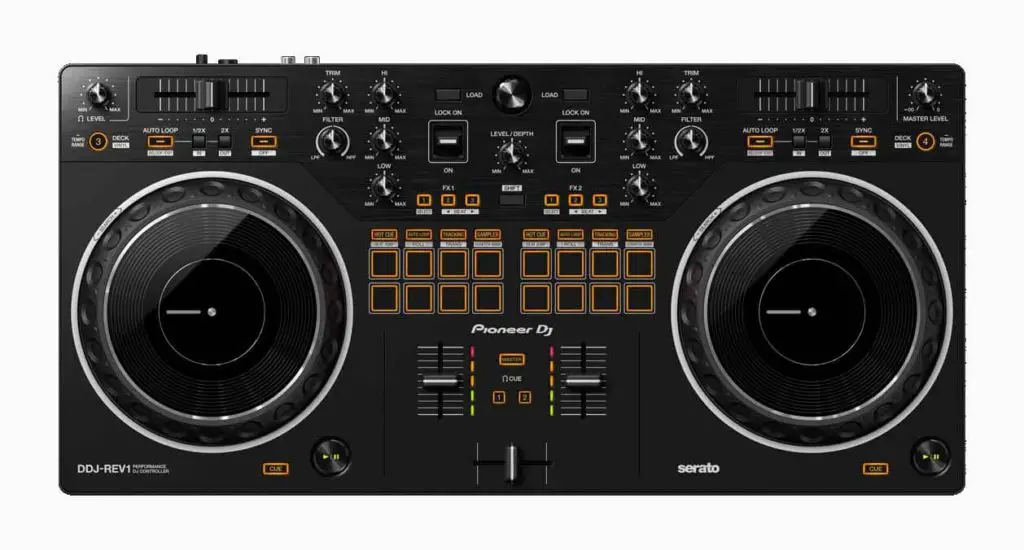
New Pioneer DDJ-Rev7 – DJ Controller Detailed Review
The conclusion
The Pioneer DDJ-Rev1 while being a younger brother of the Pioneer DDJ-Rev7 that was released alongside with it, is primarily a DDJ-SB3 successor and a new competitor in the line of entry-level Serato DJ controllers.
If you plan on getting yourself a brand new entry-level DJ controller you might have trouble choosing between the Pioneer DDJ-Rev1 and the Pioneer DDJ-400. These controllers compete with each other not only because of their vastly differently styled layouts, but also because of being made for different pieces of software (Serato vs. Rekordbox).
If you’re considering getting yourself a brand new DDJ-Rev1 be sure to also check out what the DDJ-400 has to offer.
That’s why you might want to check out: DDJ-200 vs. DDJ-400 (Which Is Better For You?)
If you liked this detailed overview, you can also check out our take on the new Pioneer DDJ-Rev7 DJ controller that came along with the DDJ-Rev1 here: New Pioneer DDJ-Rev7 – DJ Controller Detailed Review

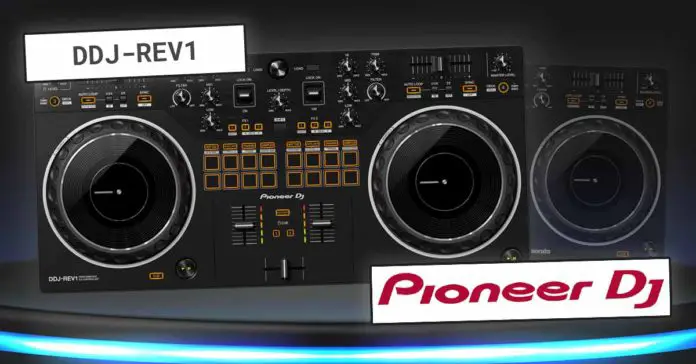
[…] New Pioneer DJ DDJ-REV1 – A Great Choice For Beginners? […]
[…] New Pioneer DJ DDJ-REV1 – A Great Choice For Beginners? […]